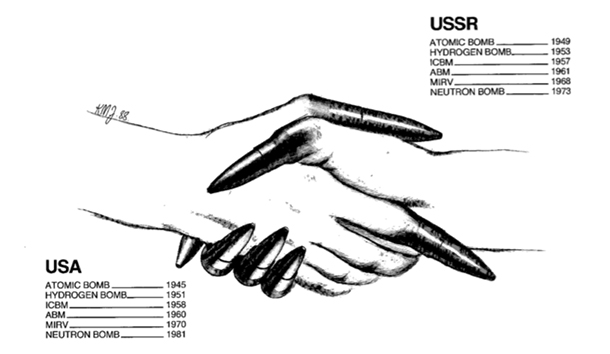Americans are perennially tempted to believe that Soviet armament is a reaction to American armament, and therefore reversible by American disarmament. For years we allowed that hope to guide our military policy: beginning in the late 1960’s, the United States exercised unilateral restraint in nuclear construction for more than a decade. American-produced IGBM warheads were deliberately designed to be ineffective against Soviet missile silos. By contrast, Soviet SS-18 and SS-19 warheads were built for maximum effectiveness against US silos. After the ABM treaty (1972), most American air defenses were dismantled, whereas the Soviets worked feverishly to improve their own and acquire the technology for an improved ABM system. So went the era of detente.
But the Soviet nuclear drive has roots in the beginning of the nuclear age. In August 1945, a directive from the ruling party’s central committee ordered that the US monopoly over atomic weapons be broken and delivery systems developed as soon as possible. More than 1,000 TU-4 bombers (copies of the B-29) were produced and the first ballistic missile was flight-tested in October 1947. During an interview, Khrushchev revealed that ABM research and development had started when ICBM’s were first conceived (New York Times, September 8, 1961). As the table below indicates, the Soviets deployed three major systems ahead of the United States.
The basic tenets of Soviet military doctrine and strategy were formulated during 1953-1960, i.e., after Stalin’s death, and Moscow dates its own “nuclear revolution in military affairs” from the time of Khrushchev’s statement on the new doctrine before the Supreme Soviet (Pravda, January 15, 1960). Based on Russian-language publications, the following principles emerge: a war with the West will be the third and decisive conflict for world domination; a nuclear war should be avoided, although national liberation movements and revolutionary wars must be supported; if deterrence fails, the East must win by limiting damage to the USSR and ensuring viability of assets.
Soviet nuclear strikes must be decisive and followed by a combined arms offensive against Western Europe. Priority targets for missiles include the enemy’s nuclear delivery systems; command, control, and communications; and air defenses. Secondary targets are politico-administrative centers, military forces, support facilities, selected industries, and transportation. All of this is predicated on the nuclear superiority of the USSR.
Official publications endorse Soviet military superiority. The goal was advocated in all three editions of Voennaia strategia by Marshal V.D. Sokolovskii and also in volume two of Voennaia entsiklopedia (1976), edited by Marshal A.A. Grechko, both ranking officers. The late Leonid Brezhnev initiated the current practice of denying military superiority as the USSR’s objective. This policy appeared in volume three of Voennaia entsiklopedia (1977), edited by Marshal N.V. Ogarkov, formerly in charge of the armed forces deception (maskirovka) directorate, who had just been appointed chief-of-staff.
During the 1970’s, the Soviets developed three essential ABM technologies: a small, movable phased-array radar for local defense; two new antiballistic missiles; and the Ryad computer. They also achieved the basis for deployment of an antisatellite system (National Intelligence Estimate November 3-8, 1980). During the current decade, they have deployed two new ICBM’s, the silo-based and mobile SS-24, as well as the exclusively mobile SS-25. Follow-on models of the SS-18 and SS-24 are being flight-tested right now. The Delta IV class nuclear-powered submarine carries a new SS-N-23 MIRVed SLBM, and eight Typhoon class submarines will be operational by the end of 1989. Both the Backfire bombers (30 produced per year) and the heavy Blackjack, now in advanced development, will be able to strike at North American targets.
For all this might, the targeting calculus that has determined the size and composition of Soviet strategic nuclear forces would be upset by any type or degree of ABM defense deployed by the United States. Even a limited US defense would undermine the probability of enemy missile penetration. Furthermore, the race to develop “exotic” ABM technology is extremely expensive and questionable for the USSR. President Reagan’s offer at Reykjavik to share mature SDI technology probably was regarded by Gorbachev as deception. The Soviets have a healthy respect for US potential and are loath to engage in an all-out technological race, even though they have been developing directed energy weapons systems for many years.
It is clear that the USSR has never shared the limitations set by the United States on strategic program goals. The Soviet objective has always been and remains to remove any effectiveness from US second strike forces. The steady shift in national priorities toward the military since the late 1950’s is proof of Moscow’s war-winning and damage-limiting objectives.
However, overt military aggression appears to be the least likely course of action. The Soviets have achieved a margin of military superiority over the West and will attempt to improve it. Their objective will not be met by some early timetable for war. The Kremlin perceives three advantages in military superiority: it makes the leaders feel more secure, it strengthens foreign policy in the effort to break up NATO, and it constitutes a “safe conduct pass” for assisting so-called national liberation and other revolutionary movements in the Third World.

Leave a Reply